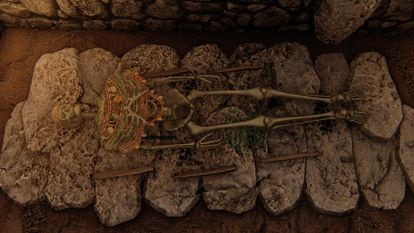More than a thousand years ago, in the heart of the avocado region of Michoacán, near Lake Pátzcuaro, there was a civilization that constantly inhabited the region of the city of Tingambato between the year 0 and 900 AD Located at the entrance to the Tierra Caliente and the cold mountain range of Michoacán, was a privileged site that was enriched by the pan-Mesoamerican distribution network of shells that reached South America. A bridge that connected the coastline of the Pacific coasts with higher areas and which is currently one of the most important archaeological sites, if not the most, in Western Mexico.
More than 40 years after its discovery, Tingambato continues to show new treasures to the team of archaeologists working in the area, although a mystery remains undisclosed.
The discovery of the grave of a woman between 15 and 19 years old, sumptuously covered with more than 19,000 objects of blue, green stones (amazonites) and seashells has been an unexpected surprise that turns not only what was known on its head. about the city, but the roles that women could have in pre-Hispanic societies.
The "warrior princess" as the group of archaeologists led by José Luis Punzo, from the National Institute of Anthropology and History (INAH) has put it, was found in 2011 near the main palace area in a tomb dating from 630 AD. , the period of greatest splendor of the city.
More information
Alert in Mexican archeology for budget drowning
13,911 archaeological remains: the uncomfortable obstacles unearthed on the Mayan Train route
The Jalisco Nueva Generación Cartel extends its power in Michoacan territory
The burial measures 12 square meters and was built with thick walls of stone and earth, a small door and a vaulted ceiling in spiral with flagstone, similar to those found in the Mayan world. What the scientists found behind those walls made them think at first that it was a warrior. The woman rested on flagstones and was surrounded by five
luxuriously crafted
spear throwers
, known as
atlatl
, a distinctive weapon of the nobility. When analyzing the DNA of the skeleton, the surprise was great. The warrior was a warrior. "It is a unique funeral trousseau," says archaeologist Punzo. "We have not found such a type of burial in western Mexico," he emphasizes.
The mixture of the masculine and feminine elements in the tomb has been something that has puzzled the investigators.
“We have realized that the western roles we are used to are much more complex in pre-Hispanic societies than we thought.
Probably identities and gender were understood in very different ways, ”says Punzo.
"I find it something exciting," he adds.
Tingambato archaeological site, Michoacán.INAH
When analyzing the objects made with shells, among which a carefully worked breastplate, a diadem and a discoidal earmuff, unique to date, it was discovered that most of the beads and earrings are made with
Spondylus princeps
, a type of conch shell. abundant on the Pacific coasts from Nayarit to Michoacán, highly valued in ancient cultures for its intense reddish color. Among the objects that honor the princess, shells originating from the Caribbean were also found, which reinforces the theory of commercial preponderance that Tingambato had in ancient times.
To complete the trousseau, the young woman's hands were richly adorned with rings that matched the strings of beads and seashells tied to the ankles. The group of archaeologists also found 2,000 small snails around the skeleton's head, suggesting that they were inserted into the hair as part of the funeral decoration.
Punzo, with decades of experience scratching in the bowels of the land of Michoacán, explains that thanks to a joint work with Harvard University and
National Geographic
magazine
,
the investigation of the warrior princess has made important advances. For example, they discovered that the young woman's skull had been deformed from birth to be conical with a bulging base, while the teeth had been filed to make the incisors more prominent. The archaeologist considers that these traits, symbols of beauty and status, are clues that indicate that women may have had a "fundamental and preponderant" position in Tingambato society.
The princess's tomb is located 70 meters from an ossuary in which in the 70s human remains of between 54 and 120 individuals were found with vessels, shell objects, colored stones and pyrite mirrors, very different from the tomb of the woman, buried alone.
"We believe that it is the burial of a family of powerful people of several generations, of governors of this city," says the archaeologist.
“Unlike the tomb of the princess, this first one has a staircase, which makes us suppose that the bodies were visited and rituals were carried out.
The young woman's grave was sealed with a small pyramid on top of it, ”explains José Luis Punzo.
Reconstruction of the tomb of the warrior princess of Tingambato.
The INAH archaeologist handles two hypotheses about the warrior princess. That she came from a different lineage than the one that ruled the city and that is why she was buried separately or that she died in labor. "In Mesoamerica, women who died in childbirth did so as warriors," she explains. Another interesting revelation is that the teeth of at least two small children have been found buried with the young woman. "Baby teeth that have nothing to do genetically with it," says the archaeologist. "A mystery yet to be solved," he adds. Precision geophysical technology, radiocarbon collagen analysis and DNA studies of the samples found in the first tomb will explain the relationship between the princess and the rest of the people buried in Tingambato.
After decades of work, the ruins show a small part of everything that remains to be discovered. The archaeologist Punzo calculates that the city covers at least one square kilometer of which, at the moment, only two hectares are known. The last year was not a good time for Mexican archeology, which suffered cuts in government budgets due to the pandemic and, in contexts such as Michoacan, it is conditioned by the violence of organized crime. To this must be added the difficult task of digging in soil rich in nutrients where archaeological remains are more than four meters deep. Punzo recognizes that such a context represents a stumbling block for his work. "At times we have had to leave excavations, as in the Durango mountains, because there were no safe conditions to continue working," he says.
Beneath billions of pesos in avocados, Tingambato's unexplored secrets wait to be unveiled one day.
The warrior princess is only the first of them.
Subscribe here
to the
newsletter
of EL PAÍS México and receive all the informative keys of the current situation of this country



/cloudfront-eu-central-1.images.arcpublishing.com/prisa/PLNY3OH7WVF7PAHBVU6Y6QKPTI.jpg)




/cloudfront-eu-central-1.images.arcpublishing.com/prisa/56FQEM4G6NDS5LIUHQJBCIVXEI.jpeg)





